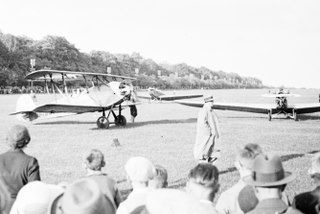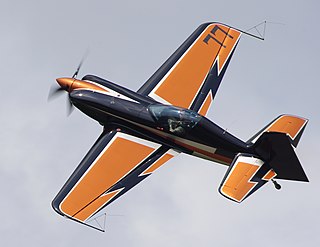Related Research Articles

The Arado Ar 231 was a lightweight floatplane, developed during World War II in Germany as a scout plane for submarines by Arado. The need to be stored inside the submarine necessitated compromises in design that made this single-seat seaplane of little practical use.

The Dornier Do 23 was a German medium bomber of the 1930s.

The AEG C.III was a two-seat biplane reconnaissance aircraft, a single prototype of which was built during World War I. The aircraft featured an unusual fuselage design that completely filled the gap between the upper and lower sets of wings, to provide the pilot with improved vision, and to allow the observer a wider field of fire for his 7.92 mm (.312 in) machine gun. The pilot sat to the rear of the observer, who was stationed over the upper wing. This design was not as successful as had been hoped, and the C.III was never entered into service. Despite being heavier than the C.II, its maximum speed increased to 158 km/h (98 mph).

The AEG D.I was a biplane fighter of World War I. Three prototypes were ordered, but after the first two were involved in serious crashes, one of which killed flying ace Walter Höhndorf on September 5, 1917, development was cancelled. A triplane version was built as the Dr.I. The second and third prototypes differed little from the first except in detail.

The Albatros C.VII was a German military reconnaissance aircraft which saw service during World War I. It was a revised and re-engined development of the Albatros C.V, which had proved disappointing in service.
The Arado Ar 195 was a single-engine prototype carrier-based torpedo bomber, built by the German firm Arado for service on the German aircraft carrier Graf Zeppelin, during World War II.

The Arado S I was a biplane trainer built in Germany in 1925. The first of three prototypes was powered by a Bristol Lucifer radial engine, while the other two Arado S.Ia aircraft were fitted with the Siemens-Halske Sh 12. The Siemens-Halske Sh 11 powered the Arado S III, a virtually identical aircraft of which only a single prototype was constructed and sold to Turkey.

The DFS 331 was a transport glider prototype developed in a collaboration between DFS and Gotha. It was a twenty-seat troop transport designed by Hans Jacobs, who had previously produced the successful, nine seat DFS 230.

The Fokker D.II was a German fighter biplane of World War I. It was a single-seat fighter aircraft developed before the Fokker D.I. It was based on the M.17 prototype, with single-bay unstaggered wings and a larger fuselage and shorter span than production D.IIs. Using a 75 kW (100 hp) Oberursel U.I, the D.II was underpowered, though the single 7.92 mm (.312 in) lMG 08 machine gun was normal for 1916. The German Army purchased 177.

The Focke-Wulf S 2 was a trainer aircraft built in Germany in the late 1920s. It was a conventional parasol-wing monoplane with fixed tailskid undercarriage. The pilot and instructor sat side by side in an open cockpit. Only a single example was built.

The Focke-Wulf S 24 Kiebitz was a sport aircraft built in Germany in the later 1920s. It was a single-bay biplane of conventional design with equal-span, unstaggered wings, braced with N-type interplane struts. The pilot and a single passenger sat in tandem open cockpits, and it was fitted with a fixed tailskid undercarriage. The wings could be folded for transportation or storage, and the aircraft was designed to be towed by a car.

The Fokker D.XIII was a fighter aircraft produced in the Netherlands in the mid-1920s. It was a development of the Fokker D.XI with a new powerplant and considerably refined aerodynamics, and had been designed to meet the requirements of the clandestine flying school operated by the German Army at Lipetsk in the Soviet Union. Like its predecessor, it was a conventional single-bay sesquiplane with staggered wings braced by V-struts. The pilot sat in an open cockpit and the undercarriage was of fixed, tailskid type. The wings were made of wood and skinned with plywood, and the fuselage was built up of welded steel tube with fabric covering.

The Gotha WD.7 was a reconnaissance floatplane developed in the German Empire during World War I.

The Heinkel HD 38 was a fighter aircraft developed in Germany in the late 1920s. It was a compact, single-bay biplane with staggered wings of unequal span, braced with N-type interplane struts, a refined version of the HD 37 that had been evaluated and rejected by the Reichswehr for use at the secret training facility at Lipetsk. The HD 38 was designed in the hope of capturing a different niche - that of a seaplane fighter, and was designed with a twin pontoon undercarriage that could be quickly removed and replaced with wheels. It was accepted in this role, but did not serve in it for long before being relegated to general training duties. Even then, it was not long before Germany abandoned the Lipetsk base to the Soviet Union.
The Heinkel He 62 was a reconnaissance seaplane designed in Germany in the early 1930s. It was a conventional, single-bay biplane with unstaggered wings of equal span. The pilot and gunner sat in tandem, open cockpits. A few aircraft were supplied to Japan, where Aichi built a version as the AB-5, and used it as the basis for the AB-6, but no series production took place. The AB-5 used a locally produced Nakajima Kotobuki in place of the Siemens engine fitted to the German-built aircraft.

The SZD-25A Lis was a single-seat glider aircraft that was designed and built in Poland from 1955, derived from the SZD-16 Gil and SZD-25 Nov.
The Albatros L 103 / Albatros Al 103 was a German experimental aircraft of the 1930s. It was a parasol-wing landplane of conventional configuration, seating the pilot and flight test observer in separate, open cockpits. The Al 103 was used to test variations in sweepback, dihedral and tailplane area.

The XtremeAir Sbach 300 is a German aerobatic aircraft, designed by Philippe Steinbach and produced by XtremeAir, of Cochstedt. The aircraft is supplied as a complete ready-to-fly-aircraft.
The Bautek Skycruiser is a German ultralight trike, designed and produced by Bautek of Kenn, Germany. The aircraft is supplied as a complete ready-to-fly-aircraft.
The Halberstadt C.III was a German single-engined reconnaissance biplane of World War I, built by Halberstädter Flugzeugwerke.
References
- Taylor, Michael J. H. (1989). Jane's Encyclopedia of Aviation. London: Studio Editions. p. 56.
- German Aircraft between 1919–1945